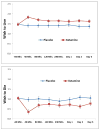Improvement in suicidal ideation after ketamine infusion: relationship to reductions in depression and anxiety
- PMID: 25169854
- PMCID: PMC4163501
- DOI: 10.1016/j.jpsychires.2014.07.027
Improvement in suicidal ideation after ketamine infusion: relationship to reductions in depression and anxiety
Abstract
Objective: Suicide is a psychiatric emergency. Currently, there are no approved pharmacologic treatments for suicidal ideation. Ketamine is an N-methyl-D-aspartate (NMDA) receptor antagonist that rapidly reduces suicidal ideation as well as depression and anxiety, but the dynamic between these symptoms is not known. The aim of this analysis was to evaluate whether ketamine has an impact on suicidal thoughts, independent of depressive and anxiety symptoms.
Methods: 133 patients with treatment-resistant depression (major depressive disorder or bipolar I/II disorder) received a single subanesthetic infusion of ketamine (0.5 mg/kg over 40 min). Post-hoc correlations and linear mixed models evaluated the relationship between suicidal ideation and depression and anxiety symptoms using the Hamilton Depression Rating Scale (HAMD), Scale for Suicidal Ideation (SSI), Beck Depression Inventory (BDI), and Hamilton Anxiety Rating Scale (HAMA) focusing on 230 min post-infusion.
Results: At 230 min post-infusion, correlations between changes in suicidal ideation and depression ranged from 0.23 to 0.44 (p < .05), accounting for up to 19% in the variance of ideation change. Correlations with anxiety ranged from 0.23 to 0.40 (p < .05), accounting for similar levels of variance. Ketamine infusion was associated with significant reductions in suicidal ideation compared to placebo, when controlling for the effects of ketamine on depression (F1,587 = 10.31, p = .001) and anxiety (F1,567 = 8.54, p = .004).
Conclusions: Improvements in suicidal ideation after ketamine infusion are related to, but not completely driven by, improvements in depression and anxiety. Investigation of the specific effects of ketamine on suicidal thoughts is warranted.
Trial registration: ClinicalTrials.gov NCT00088699.
Keywords: Depression; Ketamine; Suicidal ideation; Suicide.
Published by Elsevier Ltd.
Conflict of interest statement
Conflict of Interest
Dr. Furey is listed as a co-inventor on a patent application for the use of scopolamine in major depression and Dr. Zarate is listed as a co-inventor on a patent application for the use of ketamine and its metabolites in major depression. Drs. Furey and Zarate have assigned their rights in the patent to the U.S. Government but will share a percentage of any royalties that may be received by the Government. The remaining authors have no conflicts of interest to disclose, financial or otherwise.
Figures


References
-
- U.S. Department of Health and Human Services (HHS) Office of the Surgeon General and National Action Alliance for Suicide Prevention. Washington, DC: HHS; 2012. 2012 National Strategy for Suicide Prevention: Goals and Objectives for Action. - PubMed
-
- Beck AT, Kovacs M, Weissman A. Assessment of suicidal intention: the Scale for Suicide Ideation. J Consult Clin Psychol. 1979;47:343–52. - PubMed
-
- Beck AT, Steer RA, Kovacs M, Garrison B. Hopelessness and eventual suicide: a 10-year prospective study of patients hospitalized with suicidal ideation. Am J Psychiatry. 1985;142:559–63. - PubMed
Publication types
MeSH terms
Substances
Associated data
Grants and funding
LinkOut - more resources
Full Text Sources
Other Literature Sources
Medical

